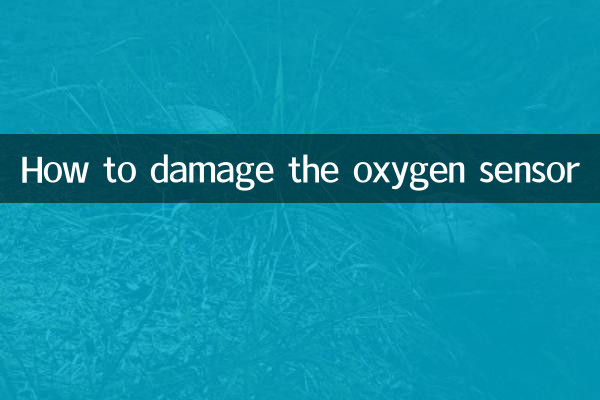How to damage the oxygen sensor
Oxygen sensors are an important component in modern automobile emission control systems. They are mainly used to monitor the oxygen content in the exhaust gas and feed data back to the engine control unit (ECU) to optimize the air-fuel ratio. However, oxygen sensors may be damaged during use for a variety of reasons, affecting vehicle performance and emissions. This article will analyze the causes and preventive measures for oxygen sensor damage based on the hot topics and hot contents of the entire network in the past 10 days.
1. Common causes of oxygen sensor damage

Damage to oxygen sensors is usually related to the following factors:
| Cause of damage | Specific performance | Preventive measures |
|---|---|---|
| Poor fuel quality | Fuel containing sulfur or lead can cause sensor poisoning | Use high-quality fuel to avoid adding inferior additives |
| Carbon deposits in the engine | Carbon deposits cover the sensor surface, affecting sensitivity | Clean carbon deposits regularly to avoid long-term idleness |
| Mechanical damage | Damage caused by collision or improper installation of sensors | Pay attention to strength during installation to avoid external impact |
| High temperature aging | Long-term high temperature operation leads to degradation of sensor performance | Check the cooling system to avoid overheating of the engine |
| Circuit failure | The signal abnormality caused by short circuit or disconnection of the line | Check the wiring harness regularly to avoid wear or corrosion |
2. Symptoms of damage to the oxygen sensor
When the oxygen sensor is damaged, the vehicle usually experiences the following symptoms:
| symptom | Possible reasons |
|---|---|
| Engine fault light on | The sensor signal abnormality triggers the ECU alarm |
| Increased fuel consumption | Air-fuel ratio offset leads to a decrease in combustion efficiency |
| Power drop | The engine enters protection mode, limits power output |
| Exhaust exhaust emissions | Black smoke or odor may be accompanied by failure in annual inspection |
3. How to prolong the service life of oxygen sensors
In order to extend the service life of the oxygen sensor, car owners can take the following measures:
1.Regular maintenance: Replace the engine oil and air filter according to the maintenance cycle recommended by the manufacturer to reduce the engine carbon accumulation.
2.Use high-quality fuel oil: Avoid using sulfur or lead-containing fuel to reduce the risk of sensor poisoning.
3.Check the exhaust system: Ensure that the exhaust system is free of leakage and prevent unburned fuel from entering the sensor area.
4.Avoid short-distance driving: Short-distance driving can easily cause the sensor to fail to reach the working temperature, which will accelerate aging in the long run.
5.Timely repair of faults: Once the engine fault light is found to be on or the fuel consumption is abnormal, the oxygen sensor should be checked in time.
4. Suggestions for replacing oxygen sensors
The lifespan of an oxygen sensor is usually around 80,000-100,000 kilometers. If the sensor is damaged, it is recommended to replace it as soon as possible. Here are the things to note when replacing:
| Things to note | illustrate |
|---|---|
| Choose original or branded parts | Make sure the sensors match the vehicle and avoid compatibility issues |
| Use special tools | Avoid damaging the sensor or exhaust manifold during removal |
| Check the line connection | Make sure the wiring harness of the new sensor is not damaged or loose |
| Reset the ECU | Clear the fault code after replacement, so that the ECU can re-learn the air-fuel ratio |
5. Summary
Damage to the oxygen sensor will not only affect vehicle performance, but will also lead to excessive emissions. By understanding the causes, symptoms and preventive measures of damage, car owners can better maintain oxygen sensors and extend their service life. Regular maintenance and timely repairs are the key to ensuring the normal operation of the oxygen sensor.

check the details

check the details